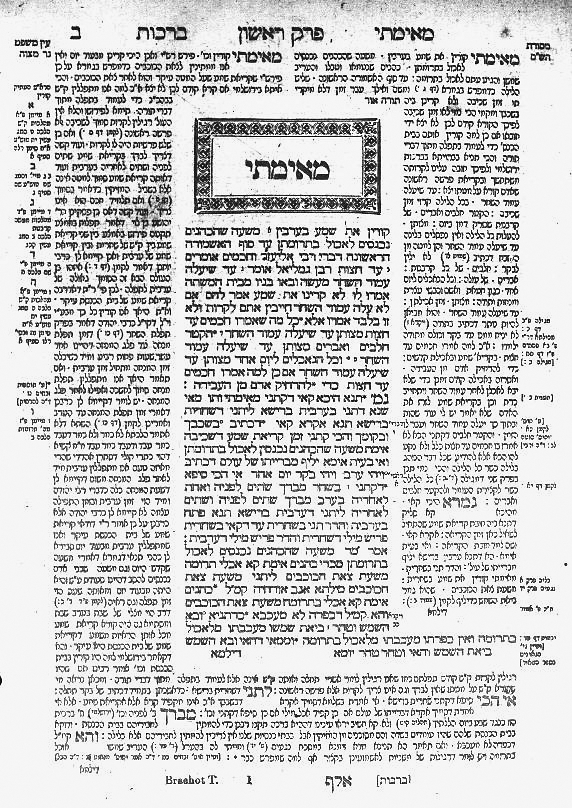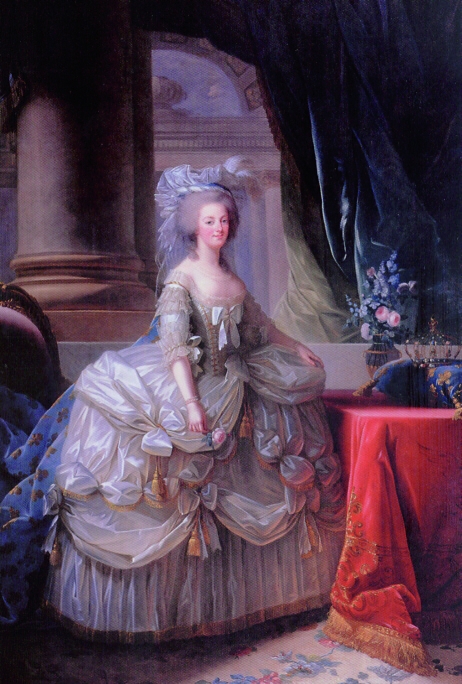Introduction
Sudden hair whitening (canities) was first reported centuries ago. Although a rare event, it has affected well-known historical figures, including Sir Thomas Moore and Queen Marie Antoinette of France. Early reports are substantiated by more recent cases in the scientific literature. Often, there is association with psychological stress; in the two historical cases above, the condition is thought to have been a reaction to the sentence of execution. In this paper, we examine some case histories of those afflicted throughout history and discuss hypotheses to explain the phenomenon.
Sudden hair whitening throughout history and literature
The first documented case of sudden hair whitening was in the Talmud (83 AD), a Jewish historical record (Figure 1).1 A scholar was appointed chief of the main Israeli Talmudic academy at the age of 17 years. His wife was concerned that he looked too young for the job and on that day, he developed 18 rows of white hair. Maimonides, a medieval Jewish rabbi, postulated that this was a consequence of strenuous studying.
Figure 1.

The first page of the Vilna Edition of the Babylonian Talmud, Tractate Berachot, folio 2a
Sir Thomas Moore refused to attend Anne Boleyn's coronation and was committed to the Tower of London in 1534. He was sentenced to execution after refusing to avow the supremacy of Henry VIII over the pope. Allegedly, his hair turned white the night before his death.2
Similarly, Marie Antionette's auburn hair turned white the night before her execution in 1793 (Figure 2).2
Figure 2.

Portrait of Marie Antoinette by Elisabeth Vigée Le Brun, 1779, Kunsthistorisches Museum, Vienna
Rayer, a French dermatologist in the early 19th century (1793–1867), noticed that many emotional triggers precipitate canities: ‘Paroxysms of rage, unexpected and unwelcome news, habitual headache, overindulgence in sexual appetite and anxiety have been known to blanch the hair prematurely’.3
The family physician, written in the early 20th century, describes a rebel sepoy of the Bengal army taken prisoner in 1861. He was stripped naked, surrounded by soldiers and within 30 minutes, his hair turned from jet black to white.4
In 1957, Ephraim, an American dermatologist, witnessed a 63-year-old man's hair turn white over several weeks having fallen down some stairs. The subject noticed loss of hair but no bald patches and 17 months later had extensive vitiligo.5
Hypotheses
Pigmentophages: Metchnikoff (1901) believed pigment was absorbed and carried away by phagocytes called ‘pigmentophages’ produced by the hair medulla.6 After being saturated with pigment, they travel through the hair bulb into connective tissue where they deposit the pigment. No such cells have been demonstrated.
Bubbles in the hair shaft: Landois (1866) thought that in sudden greying, the pigment does not alter, but colour change is an illusion due to air bubbles in the medulla and cortex of the hair shaft seen microscopically.5 Reflection of light makes the hair appear white. Modern microscopy has not supported this.
Hair changing colour spontaneously: The French physician Brown-Sequard plucked his white beard hairs daily for several weeks (1869).5 He observed that white hairs reappeared within 24 hours to the same length and site replacing those plucked. He therefore concluded that hair changes colour along the length of the shaft. This has not been reproduced and no explanation was offered.
-
Hair dye: Could the washing out of temporary hair dye explain some cases of ‘sudden onset of white hair’? Before the use of paraphenyldiamine (PPD) as a permanent hair dye in 19077 temporary vegetable and mineral dyes were used such as henna, chamomile, lead and silver.
The use of temporary hair dyes prior to 1907 may explain some cases of sudden canities. When incarcerated and sentenced to death, it is unlikely that individuals would have access to hair dye or servants to aid application. The unfortunate rebel sepoy may also have used vegetable hair dye. It is conceivable that intense interrogation in the hot Indian climate may have resulted in perspiration sufficient to wash out hair dye and we suggest that this is the only possible explanation for whitening of the hair over 30 minutes.
-
Alopecia areata: This disease results in patchy sudden alopecia and can occur overnight. It may be autoimmune and selectively affect pigmented hairs. It is possible that individuals with a mixture of white and pigmented hairs have an episode of alopecia totalis selecting out pigmented hair. Therefore, the patient is left only with white hairs, creating an illusion of hair changing colour to white.
Alopecia areata may follow an episode of stress. Case reports of sudden canities describe exclamation mark hairs, easily plucked dark hairs and coexistence of patchy alopecia areata to support this theory.8
In 1981, Guin described a lady whose hair turned white over three months with hair thinning but no patches of alopecia. Immunofluorescence showed IgM and IgG in a granular pattern along the follicular epithelium (in alopecia areata a fibrillar pattern of IgM and C3 along the follicular basement membrane zone is typical). This suggests an immunological mechanism distinct from alopecia areata.9
Animal models: The North American short-tailed weasel reversibly changes colour in winter from brown to white as camouflage, via a neuroendocrine mechanism, involving changes in melatonin, modifying pituitary hormone output. Brown compared this mechanism to that of alopecia areata in humans in a study of 37 patients with poliosis, vitiligo or alopecia areata. The analogy was based on both species manifesting alopecia and re-growth of white hair in a seasonal presentation, and testicular regression.10 This animal model raises the possibility of a similar cause of sudden hair colour changes in humans. In support of a neuroendocrine influence, Hoff reported a 40-year-old miner diagnosed with hypothalamic trauma following a mining accident. The following night, his hair became completely white, his testes became smaller and he lost his libido and potency.5
Conclusion
We conclude that there are two likely mechanisms for the phenomenon of sudden hair whitening. Firstly, the washing out, or lack of access to a temporary hair dye. Secondly, alopecia totalis selectively affecting the pigmented hair in an individual in whom the hair was part white and partially pigmented. With these two mechanisms most historical reports of sudden hair whitening can be explained.
Footnotes
DECLARATIONS —
Competing interests None declared
Funding None
Ethical approval Not applicable
Guarantor AMS
Contributorship AMS wrote most of the article and carried out much of the literature search. GWMM had the initial idea for the paper, searched the literature and carried out the editing. NJL wrote some of the paper, searched the literature and edited
Acknowledgements
None
References
- 1.Goldenhersh M. Rapid whitening of the hair first reported in the Talmud: possible mechanisms of this intriguing phenomenon. Am J Dermatol. 1992;14:367–8. doi: 10.1097/00000372-199208000-00013. [DOI] [PubMed] [Google Scholar]
- 2.Jelinek J. Sudden whitening of the hair. Bull NY Acad Med. 1972;48:1003–13. [PMC free article] [PubMed] [Google Scholar]
- 3.Rayer PF. In: A theoretical and practical treatise on the diseases of the skin. Bell J, translator. Philadelphia, PA: Carey and Hart; 1845. p. 378. [Google Scholar]
- 4.The family physician: a manual of domestic medicine. London: Cassell and Company; 1883. pp. 1020–1. [Google Scholar]
- 5.Ephraim A. On sudden or rapid whitening of the hair. Arch Derm. 1959;79:228. doi: 10.1001/archderm.1959.01560140090013. [DOI] [PubMed] [Google Scholar]
- 6.Metchnikoff E. On the process of hair turning white. Proc Roy Soc London. 1901;69:156. [Google Scholar]
- 7.Skellett AM, Webber NK, Levell NJ. “Dyeing”to be beautiful: a historical review of artificial hair colouring and its consequences. Br J Dermatol. 2006;155(Suppl. 1):62. [Google Scholar]
- 8.Plinck E, Peereboom-Wynia J, Vuzevski V, Stolz E. Grijs worden in een nacht, kan dat? Ned Tijdsch Geneeskd. 1993;137:1207–10. [PubMed] [Google Scholar]
- 9.Guin JD, Kumar V, Petersen BH. Immunofluorescence findings in rapid whitening of scalp hair. Arch Dermatol. 1981;117:576–8. [PubMed] [Google Scholar]
- 10.Brown A, Pollard Z, Jarrett W, Olkowski ZL. White hair: genetic and immunologic implications. Birth Defects Orig Artic Ser. 1982;18:1–20. [PubMed] [Google Scholar]


